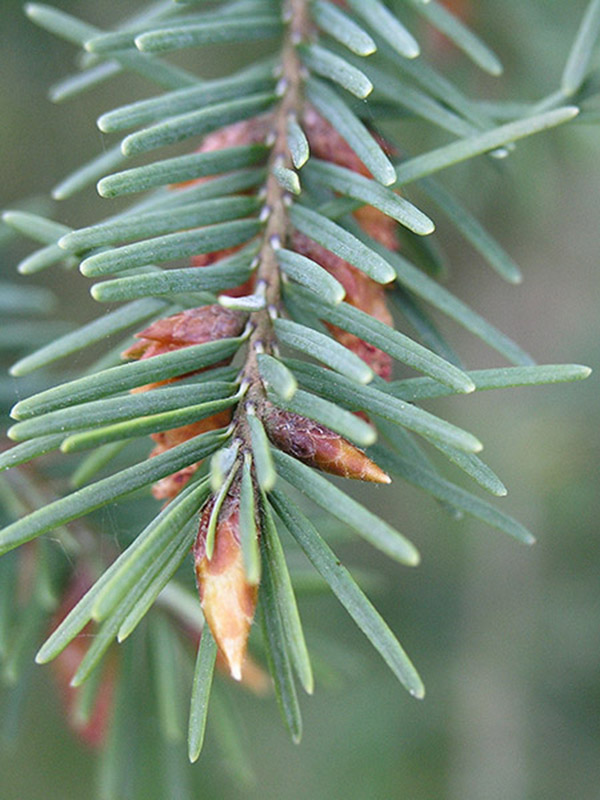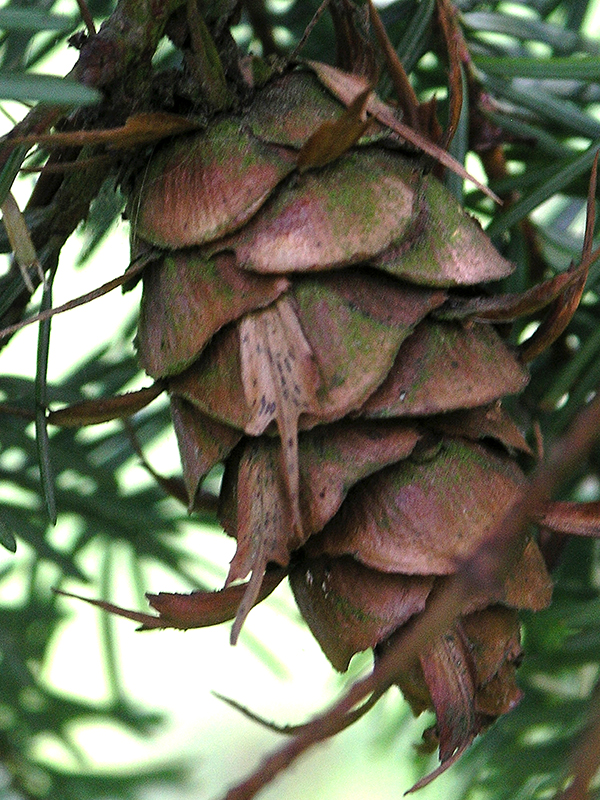
Woody > Pseudotsuga > Pseudotsuga macrocarpa > Pseudotsuga macrocarpa
Pseudotsuga macrocarpa
Bigcone Douglas Fir, Bigcone Spruce
Origin: North western area of North America.
Mike's
Opinion


"
A slow growing native evergreen, found exclusively in Southern California. Recognized by its large, unique cones and thick, horizontally fissured bark.
Michael Pascoe, NDP., ODH., CLT., MSc. (Plant Conservation)
"
| Family |
| Pinaceae |
| Genus |
| Pseudotsuga |
| Species |
| macrocarpa |
| Category |
| Woody |
| Type |
| Tree (evergreen) |
| Pronunciation |
| USDA Hardiness Zone |
| 8 |
| Canadian Hardiness Zone |
| 7b - 8a |
| RHS Hardiness Zone |
| H4 - H5 |
| Temperature (°C) |
| -12-(-7) |
| Temperature (°F) |
| 10 - 20 |
| Height |
| 15 - 30 m |
| Spread |
| 20 - 30 m |
Photographs
Description and Growing Information
Flowering Period
| General Description |
| A tall broadly conical Douglas Fir, known for the largest cones in the Pseudotsuga genus. The very stiff needles and drooping branches give this tree a similar appearance to that of a spruce. |
| Landscape |
| Not generally used in the landscape as it grows best in lean mountainous environments. However it is grown to protect watersheds. |
| Cultivation |
| Can tolerate a variety of soil requirements from bare mineral soil to deep litter. As a juvenile tree, partial shade is required and well-drained soil is preferred. |
| Shape |
| Straight as juvenile and broadly conical in maturity. |
| Growth |
| Slow |
| ID Characteristic |
| Large large cones (10 - 18 cm), consisting of spiralling bracts connected with resin. Bark is light brown/grey and made up of long, thin, bark platelets with a thick under layer of cork. The heartwood of this plant contains pockets of resin making it less stable and thus a poor choice for lumber. |
| Pests |
| Forest fires are the greatest killers of this plant. It contracts few diseases due to its growing altitude. Seeds however often succumb to fungal diseases and may fail to germinate. |
| Habitat |
| Grows in the mountains of Southern California at altitudes of approximately 1,500 m. Prefers bare mineral soils found typical of the mountainous landscape. |
| Bark/Stem Description |
| Deeply ridged, brownish-grey in colour. Consists of thin, woody platelets which are covered by a thick layer of cork. |
| Flower/Leaf Bud Description |
| Large heavy buds, obovate in shape and light brown in colour and generally 120 mm in length and often resinous. |
| Leaf Description |
| Dark blue-green in colour, needle shaped, approximately 2.5-5 cm in length. Leaves remain attached for five years and then are shed. |
| Flower Description |
| Circular clusters of long thin petals 3-5 cm in length and 90-120 mm wide. Petals are light pinkish-purple at the tips and graduate to a darker colour towards the throat of the flower. |
| Fruit Description |
| The female cones are 10-18 cm long, formed of bracts spiralling up a central stem connected with resin. |
| Colour Description |
| The foliage and bark remain the same colour year round, a dark blue green and light grey brown respectively. In September, the cones produced are a bright yellow and dry to a light brown by the start of October. Bright purple pink flowers bloom in March and persist onwards through mid-April. |
| Texture Description |
| It is a rough textured plant year round. |
| Notable Specimens |
| Mount St. Antonio, Southern California, United States of America. |
| Propagation |
| The seeds grow best in bare mineral soils in partial shade. At lower altitudes germination commences in late March, while at higher altitudes germination ends by late May. |
References
Bailey, L., & Bailey, E. (1976). Hortus third: A concise dictionary of plants cultivated in the United States and Canada. New York: Macmillan.




